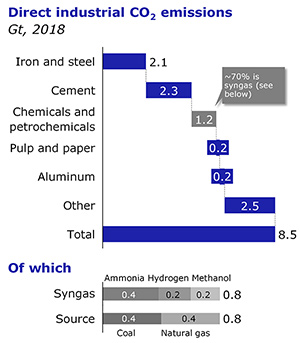A running start to net zero
Published by Callum O'Reilly,
Senior Editor
Hydrocarbon Engineering,
Starting in the 19th century, around the time of the industrial revolution (1760 – 1840), the industrial-scale production of chemicals and, later, petrochemicals has been an influential part of societal change.
Since the early beginnings, these industries have constantly evolved, adopting novel process, technology and equipment to drive efficiency improvements, increases in quality and cost reductions. Now the world faces new challenges. As the effects of climate change become apparent, many companies and countries recognise there is an urgent need to act to reduce human impact on the environment. To reduce the impact of climate change it is essential to dramatically reduce our carbon footprint in every aspect of life. Since 2003, Johnson Matthey (JM) has been recognised as a constituent of the FTSE4Good Index Series, which measures the performance of companies demonstrating strong environmental, social and governance (ESG) practices. The formation of JM’s Low Carbon Solutions business builds on the company’s strong foundation of sustainable technologies and is enabling operators to navigate the energy transition and reduce the carbon intensity of their syngas production.
Industrial sources of CO2
Globally, direct industrial emissions of carbon dioxide CO2 equate to around 8.5 Gt across the major sectors, as shown in Figure 1.1 When looking at direct industrial CO2 emissions, the chemicals and petrochemicals industry is the third largest emitting sector behind iron and steel, and cement. According to the International Energy Agency (IEA), 2018 CO2 emissions from the chemicals and petrochemicals sector were 1.2 Gt or 14% of industrial CO2 emissions. Around 70% of this 1.2 Gt (or 0.84 Gt) can be considered to come from conventional or grey synthesis gas (syngas) production; this is approximately 10% of the total global industrial CO2 emissions.
Figure 1. Direct industrial CO2 emissions (source: International Energy Agency [IEA], 2018).
Net zero targets and timescales
Companies and governments are looking into a broad range of solutions to lower the carbon intensity of industry. According to the Energy and Climate Intelligence Unit, Net Zero Tracker, 134 countries have made or are considering commitments to net zero targets stretching out to the 2050 – 2060 timeframe.2
Written by Ken Chlapik, Dominic Winch, and Carl Keeley, Johnson Matthey.
This article was originally published in the November 2021 issue of Hydrocarbon Engineering magazine. To read the full article, sign in here or register for a free trial subscription.
References
- ‘Future of Hydrogen’, International Energy Agency (IEA), (2018).
- Energy and Climate Intelligence Unit, Net Zero Tracker, https://eciu.net/netzerotracker, (accessed September 2021).
Read the article online at: https://www.hydrocarbonengineering.com/special-reports/10112021/a-running-start-to-net-zero/
You might also like
The Hydrocarbon Engineering Podcast - Education and training for every phase of the insulating system design process
In this episode of the Hydrocarbon Engineering Podcast, Brandon Stambaugh, Owens Corning Director for Technical Services, joins us to discuss engineers’ demand for education and training to support the critical phases that affect the performance and longevity of insulating systems.
Tune in to the Hydrocarbon Engineering Podcast on your favourite podcast app today.


